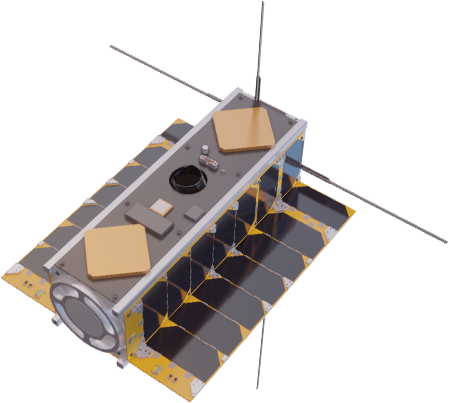 TRISAT is an educational 3U CubeSat satellite mission led by the
University of Maribor, which aims to establish a mutual cooperation
between Slovenian university students and the Slovenian space industry.
TRISAT is manifested on the first Small Spacecraft Mission Service
(SSMS) on a Vega launch vehicle in 2020, with Athena, ION CubeSat
Carrier, ESAIL, UPMSat 2, NEMO-HD, NuSat 6, GHGSat C1, Flock-4v 1-26,
Lemur-2 112-119, SpaceBEE 10-21, FSSCat A/B, NAPA 1, TARS, Tyvak 0171,
OSM 1 CICERO, DIDO 3, PICASSO, SIMBA, TRISAT, AMICal-Sat, TTU100.
http://www.trisat.um.si/
http://www.amsatuk.me.uk/iaru/formal_detail.php?serialnum=675
[Satellite]
Class: Nanosatellite, standard 3U form factor
Mass: 3.76 kg
Dimensions: 11 x 12 x 34 cm (stowed)
11 x 27 x 34 cm (deployed solar panels)
111 x 48 x 34 cm (deployed antennas)
Attitude control: 3-axis stabilized
(3 magnetorquers, 5 wheels, star tracker)
Power: 30 Wh battery, single deployable solar panels
Communication: VHF (GFSK, 9766 bps), UHF (GFSK, 9766 bps)
and S-band (OQPSK, 4 Mbps UL/DL)
Orbit determination: Global Navigation Satellite System receiver
with support for GPS, GLONASS, Galileo, BeiDou
[Telemetry downlink parameters]
Frequency: 435.6125 MHz
Bandwidth: Less than 25 kHz
Transceiver transmit power: 1 W
Modulation: GFSK, m = 0.5
Baud rate: 9766 bps
Protocol: CCSDS TM
Encoding: Combined Convolutional (7 1/2) with Reed Solomon (255,223) coding
[Uplink budget calculation]
Frequency: 145.900 MHz
Emission type: F1D
Modulation: GMSK
Data rate: 9600 bps
Protocol: CCSDS
[Downlink Budget Calculation]
Frequency: 436.500 MHz
Emission type: F1D
Modulation: GMSK
Data rate: 9600 bps
Protocol: CCSDSS
TRISAT is an educational 3U CubeSat satellite mission led by the
University of Maribor, which aims to establish a mutual cooperation
between Slovenian university students and the Slovenian space industry.
TRISAT is manifested on the first Small Spacecraft Mission Service
(SSMS) on a Vega launch vehicle in 2020, with Athena, ION CubeSat
Carrier, ESAIL, UPMSat 2, NEMO-HD, NuSat 6, GHGSat C1, Flock-4v 1-26,
Lemur-2 112-119, SpaceBEE 10-21, FSSCat A/B, NAPA 1, TARS, Tyvak 0171,
OSM 1 CICERO, DIDO 3, PICASSO, SIMBA, TRISAT, AMICal-Sat, TTU100.
http://www.trisat.um.si/
http://www.amsatuk.me.uk/iaru/formal_detail.php?serialnum=675
[Satellite]
Class: Nanosatellite, standard 3U form factor
Mass: 3.76 kg
Dimensions: 11 x 12 x 34 cm (stowed)
11 x 27 x 34 cm (deployed solar panels)
111 x 48 x 34 cm (deployed antennas)
Attitude control: 3-axis stabilized
(3 magnetorquers, 5 wheels, star tracker)
Power: 30 Wh battery, single deployable solar panels
Communication: VHF (GFSK, 9766 bps), UHF (GFSK, 9766 bps)
and S-band (OQPSK, 4 Mbps UL/DL)
Orbit determination: Global Navigation Satellite System receiver
with support for GPS, GLONASS, Galileo, BeiDou
[Telemetry downlink parameters]
Frequency: 435.6125 MHz
Bandwidth: Less than 25 kHz
Transceiver transmit power: 1 W
Modulation: GFSK, m = 0.5
Baud rate: 9766 bps
Protocol: CCSDS TM
Encoding: Combined Convolutional (7 1/2) with Reed Solomon (255,223) coding
[Uplink budget calculation]
Frequency: 145.900 MHz
Emission type: F1D
Modulation: GMSK
Data rate: 9600 bps
Protocol: CCSDS
[Downlink Budget Calculation]
Frequency: 436.500 MHz
Emission type: F1D
Modulation: GMSK
Data rate: 9600 bps
Protocol: CCSDSS